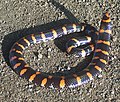| Alethinophidia 15 families |
| Family | Common names | Example Species | Example Photo |
|---|
Acrochordidae
Bonaparte, 1831 | File snakes | Arafura file snake ( Acrochordus arafurae ) |  |
Aniliidae
Stejneger, 1907 | Coral pipe snakes | False coral snake ( Anilius scytale ) |  |
Anomochilidae
Cundall, Wallach and Rossman, 1993 | Dwarf pipe snakes | Leonard's pipe snake, ( Anomochilus leonardi ) | |
Atractaspididae
Günther, 1858 | Mole vipers | Western purple-glossed snake ( Amblyodipsas unicolor ) |  |
Boidae
Gray, 1825 | Boas | Amazon tree boa ( Corallus hortulanus ) |  |
Bolyeridae
Hoffstetter, 1946 | Round island boas | Round Island burrowing boa ( Bolyeria multocarinata ) | |
Colubridae
Oppel, 1811 | Colubrids | Grass snake ( Natrix natrix ) |  |
Cylindrophiidae
Fitzinger, 1843 | Asian pipe snakes | Red-tailed pipe snake ( Cylindrophis ruffus ) |  |
Elapidae
Boie, 1827 | Cobras, coral snakes, mambas, kraits, sea snakes, sea kraits, Australian elapids | King cobra ( Ophiophagus hannah ) |  |
Loxocemidae
Cope, 1861 | Mexican burrowing snakes | Mexican burrowing snake ( Loxocemus bicolor ) |  |
Pythonidae
Fitzinger, 1826 | Pythons | Indian python ( Python molurus ) |  |
Tropidophiidae
Brongersma, 1951 | Dwarf boas | Dusky dwarf boa ( Tropidophis melanurus ) | |
Uropeltidae
Müller, 1832 | Shield-tailed snakes, short-tailed snakes | Ocellated shield-tail ( Uropeltis ocellatus ) | |
Viperidae
Oppel, 1811 | Vipers, pitvipers, rattlesnakes | European asp ( Vipera aspis ) |  |
Xenopeltidae
Bonaparte, 1845 | Sunbeam snakes | Sunbeam snake ( Xenopeltis unicolor ) | |
| Scolecophidia 3 families |
| Family | Common names | Example Species | Example Photo |
|---|
Anomalepidae
Taylor, 1939 | Dawn blind snakes | Dawn blind snake ( Liotyphlops beui ) | |
Leptotyphlopidae
Stejneger, 1892 | Slender blind snakes | Texas blind snake ( Leptotyphlops dulcis ) |  |
Typhlopidae
Merrem, 1820 | Blind snakes | Black blind snake ( Typhlops reticulatus ) | |
|










